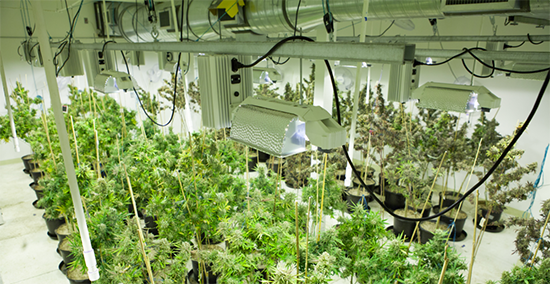Photo: Bondi Farms
If you look around any of the industrial grow rooms that have sprung up in states with recreational marijuana laws, you’ll see an ocean of green – a sea of fauna. What you would hear though, is always the same constant humming sound of the resident HVAC system. Air circulation is a key factor to control in a grow operation. In any grow operation bigger than a few cubic feet, inline fans are usually used for air circulation. For most people, though, these types of setups will be footage in music videos, documentaries, and news clips. The more common, grassroots, grow is a microgrowery with unique constraints. Most people need to have stealth microgrows that require sacrifices in efficiency to keep smell and sound levels down. Small grows are what the people have been doing for years. Whether in closets, cabinets, cases, or boxes, the marijuana microgrowery scene has certainly grown along with the cannabis industry and benefitted from many of the same advancements in technology.
Most people don’t have a spare room to dedicate to growing. In fact, with the legal amount of six plants that most medical and recreational users of marijuana are allotted, it oftentimes just isn’t worth it to dedicate a whole room and home remodeling project to grow a few plants. Over the last decade, the marijuana technology industry has seen an uptake in pre-assembled all-in-one grow boxes like Leaf. Growing your own medicine is an experience that lets you get up-close and personal with your marijuana and truly appreciate it.
Most growers are conscious of their neighbors and don’t want to expose them to unwanted light sources or odors. The process of creating a grow box is all about efficiency in space, energy, and circulation within the given constraints. Microgrowers often combine carbon filters (called scrubbers) and PC fans in some combination to filter the air coming in as well as the pungent odors exiting the box.
Every fan has a cubic feet per minute (CFM) rating, a static pressure (SP) rating, and a decibel range depending on the speed of the fan. To make an automobile comparison, CFM is like horsepower while SP is like torque. SP is what is necessary when something, like a carbon filter, physically obstructs the flow of air to or from the fan. For a PC fan cooled microgrow, home-made carbon filters should be around 1 inch thick. Growers around the world also argue about whether it’s better to have fans “push” air through the scrubber or “pull” it through.
There were two PC fan brands that repeatedly come up in a Rollitup forum discussion titled, Are computer fans strong enough to pull through a small carbon filter? Noctua is a popular gaming PC fan maker that specializes in silent fans with respectable CFM and SP ratings. Another highly used PC fan maker, focused on the heavy duty server farm cooling side of the industry, is Delta. Noctua fans utilize a self-stabilizing oil pressure bearing, and are guaranteed for up to six years. These same brands are mentioned time and time again by microgrowers at forums such as /r/microgrowery, icmag, rollitup, and thctalk who have all relied on Noctua fans to provide much needed circulation for their stealth microgrows.
You need your fans to be running at under 20 decibels to be truly considered silent from somewhere else in the same room. Inline fans are often rated around 60-70 decibels, around the loudness level of a piano.The accepted way to mute the noise on your inline fan-driven scrubber (which is muting the loudness of your microgrow) is to tie a sleeping bag to the very end – neither stealth nor sleek. With many simple tools or hacks, you can adjust the sound/speed of your PC fan until you have an acceptable ratio. Good inline fans that have temperature and speed controls or silent modes often cost well over $100, as opposed to under $20 for a PC fan. Thus, at lower decibel levels, PC fans are the ultimate bang for your buck. The lower price and decibel levels are two reasons why PC fans have been the microgrowery go-to choice for decades.











